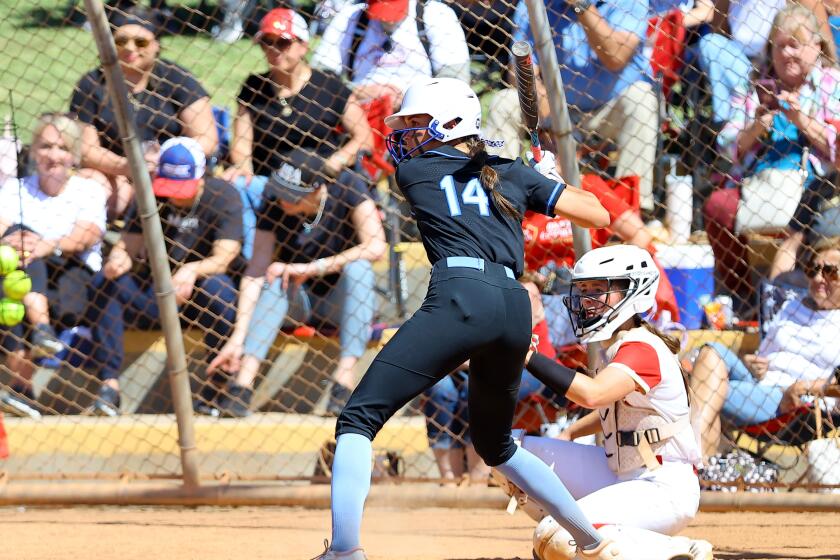Fans Find Real Thing in Omaha
- Share via
It was P.T. Barnum who first theorized that there’s a sucker born every minute, and it was Bud Selig who believed each and every one of them would be filling major league ballparks just as soon as the moss could be wiped off the baseballs and the players wandered back from their eight-month unpaid vacations.
But P.T. Barnum has been dead a hundred years now, and the suckers aren’t as dumb as they used to be. You might be able to raise ticket prices on them and get away with it, but once you raze the World Series, you might as well start booking clowns and high-wire acts, because the mere crack of the bat just isn’t going to do it anymore.
The mere clank of the bat, however, is sounding more and more like a Sunday morning church bell.
Some attendance figures from baseball games played on Monday:
--At New York: 14,197.
--At Houston: 11,238.
--At San Francisco: 9,275.
--At San Diego: 7,233.
--At Omaha: 18,063.
Omaha, of course, is the site of the College World Series, where the amateurs are beating the pros on a daily and nightly basis. The purists’ allegiance has switched to the kids with the ductile metallic alloy in their hands. Aluminum siding, so to speak. Having had suspended baseball, replacement baseball and we’re-back-you-may-now-bow-before-us baseball shoved under their noses, the fans have decided to look the other way and embrace Rosenblatt baseball as the one true game.
Fact: Major-league attendance so far in 1995 is down 26% from 1994.
Fact: Friday’s opening session of the College World Series drew a record crowd of 19,505 and tournament attendance is about 3,000 ahead of the record pace set in 1993.
Conclusion: Baseball isn’t altogether sick. Not the whole sport. A distinction has to be made. The major league version may be in dire need of a heart, mind and soul transplant, but the college game is flourishing, and it’s not difficult to spot the reasons why.
Check out the uniforms in Omaha this week. Most of them are filthy. Brick dust on the shins, grass stains across the knees, rings around the collars. The players are making a mess of themselves, and they don’t seem to care.
I have not seen a single player take a cellular phone call in the dugout to have his agent remind him to knock the mud off his cleat because the cleat logo is covered and the cleat manufacturer is getting quite miffed about missing out on some primo national TV exposure. At the College World Series, image isn’t everything.
At the College World Series, “It is more important to look good than to play good” doesn’t wash.
Jerseys and pants get washed and that’s about it.
People watch the College World Series for same reasons they dig out the old home movies from time to time. They watch for the nostalgia value--to watch a game be played the way it used to be, and ought to be, but almost never is anymore on the big stage.
Rosenblatt Stadium becomes a time machine, filled with players who run out infield grounders and slide head-first into first base; with outfielders who run over teammates and into fences chasing down fly balls; with cleanup hitters who pull up on their downtown swings and willingly bunt the runner over to third base; with pitchers who go eight innings on two days’ rest not because winning is everything, but because not losing twice in nine days most certainly is.
Fundamental baseball is practiced here. Sacrifice bunts are pushed to the right side of the mound. Outfield relays are aimed at the correct cutoff man. Is it any wonder why the Augie Garridos and the Mike Gillespies choose to make this their life’s work? The College World Series is a baseball coach’s nirvana, a magical place where, in 1995, orders on a diamond are given and orders on a diamond are obeyed.
Gene Mauch, the Little General of Little Ball, would have been Alexander the Great at this level.
Outside the lines, the game is also different at Rosenblatt.
Minutes before the first pitch, players can be found signing baseballs and handing them to small children. They say “hello” to the small children. They shake their hands and pat them on the head. Repeat: This is at a baseball game, not a $15-a-head card show.
In the stands there are no trophy wives with shiny baubles and big hair. But there are plenty of moms and dads with faded booster jackets and big voices. Monday, after Cal State Fullerton’s Mark Kotsay hit his game-breaking grand slam against Tennessee, the ESPN cameras found Kotsay’s father, Steve, so overwhelmed with pride and joy he could barely speak.
It was the best baseball interview I’ve heard all season.
The players get choked up, too, at the College World Series. Here, the tears flow freely as one team and then another encounters elimination. Tom Hanks had it wrong in “A League Of Their Own.” There is crying in baseball--you see it every year in Omaha. No one seems to mind much, either. Honest effort, honest emotion--in Omaha, no one seems to have the P.R. savvy to know this is patently, unfashionably uncool.
Yet, the crying game appears to have found a market, and it is no small market. No, only Rosenblatt Stadium is too small, suddenly cramped and in a bind to provide enough seats to serve the teeming masses.
Too bad they don’t play these games in Milwaukee or Anaheim, Atlanta or New York, Chicago or San Diego. Lots of available seats there.
More to Read
Go beyond the scoreboard
Get the latest on L.A.'s teams in the daily Sports Report newsletter.
You may occasionally receive promotional content from the Los Angeles Times.










